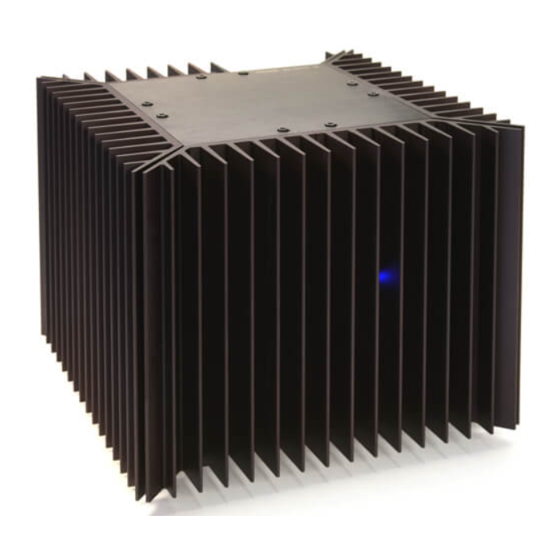
Advertisement
Quick Links
Advertisement

Summary of Contents for Pass Laboratories Pass Aleph 60
- Page 1 Volksamp Pass Aleph 60 Owner's Manual...
- Page 2 The Pass Aleph 60’s ancestry lies in the highly praised Aleph 2. We have kept virtually all of the circuit design and choice of parts intact, and the output wattage rating has been adjusted to the smaller heat sinks.
- Page 3 600 watt toroidal power transformer. One of the biggest differences in the Pass Aleph 60 is the type of chassis and heat sink used. The Aleph 2 was machined entirely from aluminum extrusions stock. While this resulted in a unique and very functional appearance, it had several drawbacks.
- Page 4 Setup The amplifier has four connections and one switch: The first connection and switch is the AC line power system. The amplifier's voltage and current rating are indicated on the bottom. It will be either 240 volts, 120 volts, or 100 volts, all with a 3AG slow blow type fuse. The frequency rating of the AC line source is 50 to 60 Hz.
- Page 5 The amplifier does not require any maintenance. While the design is conservative, this is a hard running amplifier, as single ended Class A operation is the least efficient operating mode. In fifteen years the electrolytic power supply capacitors will get old. Depending on usage, you will begin to have semiconductor and other failures between 10 and 50 years after date of manufacture.
- Page 6 Lacking an ability to completely characterize performance in an objective manner, we should take a step back from the resulting waveform and take into account the process by which it has been achieved. The history of what has been done to the music is important and must be considered a part of the result.
- Page 7 Virtually all the amplifiers on the market are based on a push-pull symmetry model. The push- pull symmetry topology has no particular basis in nature. Is it valid to use air's characteristic as a model for designing an amplifier? If you accept that all processing leaves its signature on the music, the answer is yes.
- Page 8 amplifiers and D/A and A/D converters. They are not monotonic: the distortion increases as the level decreases. The usual electrical picture of an audio signal is as an AC waveform, without a DC component. Audio is represented as alternating voltage and current, where positive voltage and current alternates with negative in a reciprocal and symmetric fashion.
- Page 9 For a 100 watt amplifier, this would be 200 watts out of the wall at idle. As the Pass Aleph 60 idles at four times its rated output, I think we can safely think of it as “pure”.
- Page 10 5 amps. The largest are capable of peaks of 25 amps each, and are run in parallel pairs. The power Mosfets in the Pass Aleph 60 have chip temperatures ratings to 150 degrees Centigrade, and we operate them at small fractions, typically 20% of their ratings. For extended life, we do not allow chip temperatures to exceed 85 degrees C.
- Page 11 The Pass Aleph 60 is warranted by Volksamp to meet performance specifications for 3 years from date of manufacture. During that time, Volksamp will provide free labor and parts at the manufacturing site.
-
Page 12: Specifications
SPECIFICATIONS Gain 20dB balanced, 20dB single ended Freq. Response - 0.5 dB @ 2 Hz, -1.5 dB @ 100 KHz Power Output 60 watts/ch @ 8 ohms, 100 watts @ 4 ohms @ 1% THD Maximum Output 32 volts, 8 amps Distortion (1KHz) 0.2% @ 60 watts, 8 ohms...
















Need help?
Do you have a question about the Pass Aleph 60 and is the answer not in the manual?
Questions and answers